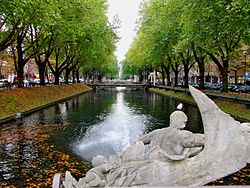This article needs additional citations for verification .(January 2015) |
A shopping street [1] or shopping district [2] is a designated road or quarter of a municipality that is composed of retail establishments (such as stores, boutiques, restaurants, and shopping complexes). Such areas may be pedestrian-oriented, [3] with street-side buildings and wide sidewalks. They may be located along a designated street, or clustered in mixed-use commercial area.
Contents
- Africa
- Cameroon
- Egypt
- Ghana
- Morocco
- South Africa
- Tunisia
- Asia
- Armenia
- Azerbaijan
- Bangladesh
- Georgia
- China
- India
- Indonesia
- Iraq
- Iran
- Israel
- Japan
- Kuwait
- Lebanon
- Malaysia
- Nepal
- Pakistan
- Philippines
- Saudi Arabia
- Singapore
- South Korea
- Taiwan
- Thailand
- Turkey
- Vietnam
- Europe
- Austria
- Belgium
- Bosnia and Herzegovina
- Bulgaria
- Croatia
- Cyprus
- Czech Republic
- Denmark
- Finland
- France
- Germany
- Greece
- Hungary
- Ireland
- Iceland
- Italy
- Latvia
- Lithuania
- Luxembourg
- Montenegro
- Netherlands
- North Macedonia
- Norway
- Poland
- Portugal
- Romania
- Russia
- Serbia
- Slovakia
- Spain
- Sweden
- Switzerland
- Ukraine
- United Kingdom
- North America
- Canada
- Costa Rica
- Dominican Republic
- Guatemala
- Mexico
- Panama
- United States
- South America
- Argentina
- Brazil
- Bolivia
- Chile
- Colombia
- Paraguay
- Peru
- Uruguay
- Venezuela
- Oceania
- Australia
- New Zealand
- See also
- References
- External links
In larger cities, there may be multiple shopping streets or districts, often with distinct characteristics each. Businesses in these areas may be represented by a designated business improvement association.
Examples of shopping streets and districts, organized by location, include:



















































